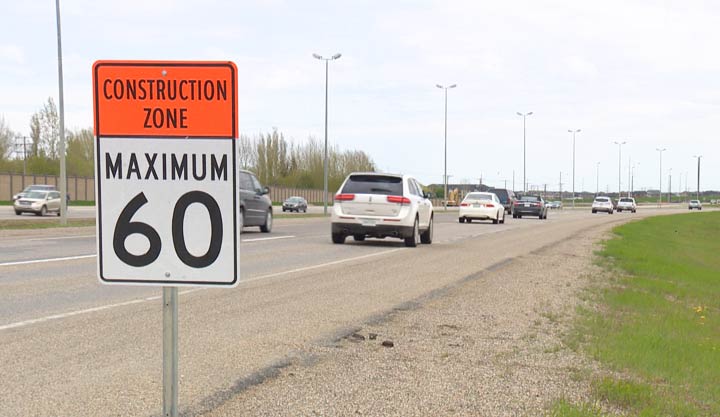The president of the Saskatchewan Heavy Construction Association says workers in highway construction zones perform dangerous work.

Shantel Lipp said that is why they deserve respect from drivers going through their workplace.
“That construction zone is their workplace and they have a right to the same protection as professionals in any office or other workplace in the province,” Lipp said Thursday in a statement.
“Construction zones are not there to inconvenience you, but are necessary to improve road safety for everyone.”
Police will be on the lookout for speeders in construction zones during July to ensure those workers are kept safe, said the chief operating officer of Saskatchewan Government Insurance’s (SGI) auto fund.
“You won’t gain any extra time by speeding through that construction zone, especially if you end up getting pulled over by law enforcement,” Penny McCune said.
“What you will do is endanger the lives of those working to improve our province’s roads.”
Under provincial law, drivers are required to slow to 60 km/h when passing a highway worker, flag person or highway equipment with flashing lights.

Get breaking National news
SGI said fines are steep for those caught speeding in an orange zone.
A driver caught going 100 km/h in a construction zone faces a fine of $1,008 along with three demerit points under the safe driver recognition program.
SGI said photo radar cameras will also be used to catch speeders in construction zones.
Reducing speed gives drivers more time to react to a potential collision, SGI added.
Speeding on the increase
There has been an uptick in dangerous driving during the pandemic, the Canadian Automobile Association (CAA) reported.
The CAA said 44 per cent of Canadians in a recent poll reported someone speeding in the past few months.
Other troubling trends the CAA reported were aggressive driving, reckless driving and drivers using cellphones.
“These numbers are concerning,” said Ian Jack, vice-president of public affairs for the CAA’s national office.
“It doesn’t matter if you are going for a five-minute trip to the store, or a 30-minute scenic drive, keeping each other safe on and around our roads should always be top of mind.”
Police have also noticed an increase in speeding.
The Regina Police Service (RPS) drove the point home during a public education and enforcement drive in June “to put the brakes on speeding.”
“Our members have noticed it and residents have noticed it,” Sgt. Mark Verbeek with the RPS traffic safety unit said on June 9.
“Excessive speed and excessive vehicle noise on our roadways is problematic and it’s dangerous.”
In recent weeks, the Saskatoon Police Service has tweeted out instances when excessive speeding tickets were issued.
The most recent was on June 28 when officers reported catching a driver going 111 km/h in a 50 km/h zone.
Five days before that, Saskatoon police said a driver was clocked going 120 km/hour in a 60 km/h zone.
In both cases, the vehicle was impounded for seven days.
The CAA said it polled 2,824 Canadians between June 5 and June 16, which it said has a margin of error of +/- 1.84 per cent, 19 times out of 20.











Comments